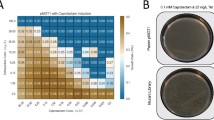Summary
The most striking phenotype associated with superoxide dismutase (SOD) deficiency in Escherichia coli is the inability to grow in aerobic minimal medium, which is due to the sensitivity of several amino acid biosynthetic pathways to superoxide. We have isolated two classes of pseudorevertants that grow on minimal medium at modest rates. Of these, the class that exhibited the faster growth carries mutations at a single locus, denoted ssa, which was mapped to 4 min on the E. coli chromosome. This class constituted the majority of the spontaneous pseudorevertants that were selected by the transfer of independent SOD-deficient cultures in minimal medium from anaerobic to aerobic growth conditions. Pseudoreversion at ssa suppressed requirements for a variety of unrelated amino acid supplements. Further, the SOD-deficient strains were unable to assimilate diaminopimelic acid from the growth medium, whereas the ssa pseudorevertants did so. The viability of these pseudorevertants indicates that superoxide-sensitive biosynthetic enzymes do retain some function in SOD-deficient cells during aerobic growth.
Similar content being viewed by others
References
Bendiak DS, Friesen JD (1981) Organization of genes in the four minute region of the Escherichia coli chromosome: evidence that rpsB and tsf are co-transcribed. Mol Gen Genet 181:356–362
Bilinski T, Krawiec Z, Liczanski A, Litwinska J (1985) Is hydroxyl radical generated by the Fenton reaction in vivo? Biochem Biophys Res Commun 130:533–539
Bukhari AI, Taylor AL (1971) Genetic analysis of diaminopimelic acid- and lysine-requiring mutants of Escherichia coli. J Bacteriol 105:844–854
Carlioz A, Touati D (1986) Isolation of superoxide dismutase mutants in Escherichia coli: is superoxide dismutase necessary for aerobic life? EMBO J 5:623–630
Chang Y-Y, Cronan JE Jr (1982) Mapping nonselectable genes of Escherichia coli by using transposon Tn10: location of a gene affecting pyruvate oxidase. J Bacteriol 151:1279–1289
Clark D (1981) Regulation of fatty acid degradation in Escherichia coli: analysis by operon fusion. J Bacteriol 148:521–526
Coleman J, Raetz CRH (1988) First committed step of lipid A biosynthesis in Escherichia coli: sequence of the lpxA gene. J Bacteriol 170:1268–1274
Fee JA, Niederhoffer EC, Naranjo C (1988) First description of a variant of E. coli lacking superoxide dismutase activity yet able to grow efficiently on minimal, oxygenated medium. In: Hurley LS, Keen CL, Lonnerdal B, Rucker RB (eds) Trace elements in man and animals. Plenum Press, NY, pp 239–243
Foster TJ, Davis MA, Roberts DE, Takeshita K, Kleckner N (1981 a) Genetic organization of transposon Tn10. Cell 23:201–213
Foster TJ, Lundblad V, Hanley-Way S, Halling SM, Kleckner N (1981 b) Three Tn10-associated excision events: relationship to transposition and role of direct and inverted repeats. Cell 23:215–227
Fridovich I (1985) Superoxide dismutases: regularities and irregularities. The Harvey Lectures, Series 79. Academic Press, New York, pp 51–75
Icho T, Sparrow CP, Raetz CRH (1985) Molecular cloning and sequencing of the gene for CDP-diglyceride synthetase of Escherichia coli. J Biol Chem 260:12078–12083
Imlay JA, Fridovich I (1991) Assay of metabolic superoxide production in Escherichia coli. J Biol Chem 266:6957–6965
Imlay JA, Linn S (1987) Mutagenesis and stress responses induced in Escherichia coli by hydrogen peroxide. J Bacteriol 169:2967–2976
Kadner RJ, Heller K, Coulton JW, Braun V (1980) Genetic control of hydroxamate-mediated iron uptake in Escherichia coli. J Bacteriol 143:256–264
Kuo CF, Mashino T, Fridovich I (1987) α,β-Dihydroxy acid dehydratase: a superoxide-sensitive enzyme. J Biol Chem 262:4724–4727
Loewen PC (1984) Isolation of catalase-deficient Escherichia coli mutants and genetic mapping of katE, a locus that affects catalase activity. J Bacteriol 157:622–626
van Loon APGM, Pesold-Hurt B, Schatz G (1986) A yeast mutant lacking mitochondrial manganese-superoxide dismutase is hypersensitive to oxygen. Proc Natl Acad Sci USA 83:3820–3824
Low KB (1987) Mapping techniques and determination of chromosome size. In: Neidhardt FC (ed) Escherichia coli and Salmonella typhimurium. Am Soc Microbiol, Washington, DC, pp 1184–1189
Miller JH (1972) Experiments in molecular genetics. Cold Spring Harbor Laboratory Press, Cold Spring Harbor, NY
Wu TT (1966) A model for three-point analysis of random general transduction. Genetics 54:405–410
Author information
Authors and Affiliations
Additional information
Communicated by J. Lengeler
Rights and permissions
About this article
Cite this article
Imlay, J.A., Fridovich, I. Isolation and genetic analysis of a mutation that suppresses the auxotrophies of superoxide dismutase-deficient Escherichia coli K12. Molec. Gen. Genet. 228, 410–416 (1991). https://doi.org/10.1007/BF00260634
Received:
Issue Date:
DOI: https://doi.org/10.1007/BF00260634




